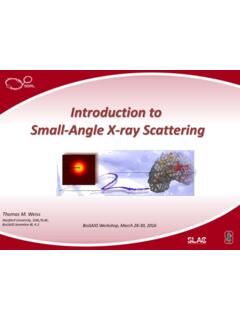Transcription of 8.09(F14) Chapter 4: Canonical Transformations, Hamilton ...
1 Chapter 4 Canonical Transformations, Hamilton -Jacobi Equations, andAction-Angle VariablesWe ve made good use of the Lagrangian formalism. Here we ll study dynamics with theHamiltonian formalism. Problems can be greatly simplified by a good choice of generalizedcoordinates. How far can we push this?Example: Let us imagine that we find coordinatesqithat are all cyclic. Thenp i= 0, sopi= iare all constant. IfHis conserved, then:H=H( 1,.., n)( )is also constant in time. In such a case the remaining equations of motion: Hq i== i( )= i qi it+ i( ) All coordinates are linear in time and the motion becomes very might imagine searching for a variable transformation to make as many coordinates aspossible cyclic.
2 Before proceeding along this path, we must see what transformations Generating Functions for Canonical Transforma-tionsRecall the the Euler-Lagrange equations are invariant when:60 Chapter 4. Canonical TRANSFORMATIONS, Hamilton -JACOBIEQUATIONS, AND ACTION-ANGLE VARIABLES a point transformation occursQ=Q(q,t) withL[q,t] =L [Q,t];dF[q,t] a total derivative is summed to the LagrangianL =L+.dtForHwe consider point transformations in phase space:Qi=Qi(q,p,t)andPi=Pi(q,p,t),( )where the Hamilton s equations for the evolution of the Canonical variables (q,p) are satisfied: Hq i= Handp i= pi.
3 ( ) qiGenerally, not all transformations preserve the equations of motion. However, the trans-formation iscanonicalif there exists a new Hamiltonian:K=K(Q,P,t),( )where K Qi= K andPi= Pi .( ) QiFor notational purposes let repeated indices be summed over s principle can be written as: t2 (piq i H(q,p,t))dt= 0,( )t1or in the new Hamiltonian as:t2 (PiQit1 K(Q,P,)t)dt= 0.( )For the Eq.( ) to imply Eq.( ), then we need: (piq i H) =PiQi K+F.( ) SinceFis a total derivative and the ends of the path are fixed: q|t2= 0and p|t2tt1t1= 0 F|2t1= 0( )There are a few things to be said about transformations and.
4 If = 1 then the transformation iscanonical, which is what we will study. If 6= 1 then the transformation isextended Canonical , and the results from = 1 canbe recovered by 4. Canonical TRANSFORMATIONS, Hamilton -JACOBIEQUATIONS, AND ACTION-ANGLE VARIABLES IfQi=Qi(q,p) andPi=Pi(q,p) without explicit dependence on time, then thetransformation isrestricted will always take transformationsQi=Qi(q,p,t) andPi=Pi(q,p,t) to be invertiblein any of the Canonical variables. IfFdepends on a mix of old and new phase space variables,it is called agenerating functionof the Canonical transformation .
5 There are four importantcases of us takeF=F1(q,Q,t)( )where the old coordinatesqiand the new coordinatesQiare independent. Then: Fpiq i 1H=PiQi K+F1=PiQi K+ F1+ t F1q i+ qi Qi( ) Qi from this we see thatPiQicancels and equating the terms with aq i, aQiand theremaining terms gives: F1pi= F,Pi= Qi 1 F1andK=H+ Qi,( ) twhich gives us formula for a transformation :pi=pi(q,Q,t)andPi=Pi(q,Q, t)( )and connectsKto an : ifQF1= ,( )qthen: F1p=Q= q FandP=q2 11= Q.( )qWriting the new coordinates as function of the old ones yieldsQ=pq21andP=( )qExample: Given the transformationsQ= ln(pqandq)P= (2p+ 12),( )q62 Chapter 4.
6 Canonical TRANSFORMATIONS, Hamilton -JACOBIEQUATIONS, AND ACTION-ANGLE VARIABLESwe can prove they are Canonical by finding a corresponding generating function. Weknow: F1=p=qeQ,( ) qwhich gives usF1= qeQq2dq+g(Q) =eQ+g(Q),( )2and FP= 1q2= Q dgeQ2 q=dQ (2p+ 12)q=q (2+ 12)eQ g(Q) =eQ.( )ThusF1is given by:F1=(q2+ 1)eQ.( ) :F=F2(q,P,t) QiPi( )where we wish to treat the old coordinatesqiand new momentaPias independentvariables. Then: F q ipi H=QiPi 2K+F2 QiPi QiPi= QiPi K+ F2+ t F2q i+ qi Pi( ) PiThis corresponds to F2pi= F2;Qi= qi F2andK=H+ Pi.
7 ( ) could also takeF=F3(p,Q,t) +qipi( )with the new coordinatesQiand the old momentapias independent we could takeF=F4(p,P,t) +qipi QiPi( )with the old momentapiand new momentaPias independent can be summarized in the table 4. Canonical TRANSFORMATIONS, Hamilton -JACOBIEQUATIONS, AND ACTION-ANGLE VARIABLESF unctionTransformationsSimplest caseF1(q,Q,t) F1pi= F,Pi= qi 1 QiF1=qiQiQi=pi,Pi= qiF2(q,P,t) F2pi= F2,Qi= qi PiF2=qiPiQi=qi,Pi=piF3(p,Q,t) Fqi= 3 F,Pi= pi 3 QiF3=piQiQi= qi,Pi= piF4(p,P,t) Fqi= 4 F4,Qi= pi PiF4=piPiQi=pi,Pi= qiThe simplest case of the 2nd(F2) transformation is just an identity transformation .
8 For anyof theseFicases we also have: FiK=H+.( ) tIfFiis independent of time then this impliesK=H( )Mixed cases may also occur when more than two old Canonical coordinates are present. (Inthis Chapter we will be using Einstein s repeated index notation for implicit summation,unless otherwise stated.)Example: considerF2=fi(q,t)Pi( )for some functionsfiwherei {1,..,n}. Then F2Qi==fi(q,t)( ) Piis a coordinate point transformation . It is Canonical with fipi=Pj,( ) qjwhich can be inverted to getPj=Pj(q,p,t).Example: Consider the harmonic oscillator:p2H=kq2+2mwherek=m 2( )264 Chapter 4.
9 Canonical TRANSFORMATIONS, Hamilton -JACOBIEQUATIONS, AND ACTION-ANGLE VARIABLESLet us try the transformation :p= 2mPcos(Q)( ) q= m 2mPsin(Q)for constant. Then:K=H=P 2(cos2(Q) + sin2(Q))=P 2,( )so the new momentumEP=( ) 2is just proportional to the energy, whileQis a cyclic this transformation Canonical ? We can find a generating functionF=F1(q,Q) bydividing the old variables:p=m cot(Q).( )qThis gives us: F1p=1F q 1= p(q,Q)dq+g(Q) =m q2cot(Q) +g(Q)( )2 FP= 1m q2= Qdg2 sin2(Q) dQSetting:dg2= 0dQ q2P=sin2(Q),( )m which tells us the transformation is Canonical if =.
10 This means:EP=( ) By Hamilton s equations Eq.( ): K Q== P Q= t+ .( )Putting this altogether, this gives the familiar results:q= 2 Esin( t+ )( )m 2p= 2mEcos( t+ ).Lets record for future use our final Canonical transformation here:q= 2 Psin(Q),p= m 2m Pcos(Q).So far, a transformationQ=Q(q,p,t) andP=P(q,p,t) is Canonical if we can find agenerating functionF. This involves integration, which could be complicated, so it wouldbe nice to have a test that only involves differentiation. There is one!65 Chapter 4. Canonical TRANSFORMATIONS, Hamilton -JACOBIEQUATIONS, AND ACTION-ANGLE Poisson Brackets and the Symplectic ConditionIn Classical Mechanics II ( ) thePoisson bracketof the quantitiesuandvwas definedasu{u,v}q,p i( = v qi v pi u qi( ) pi)It is easy to check that the following fundamental Poisson bracket relations are satisfied:{qi,qj}q,p={pi,pj}q,p= 0and{qi,pj}q,p= ij.














